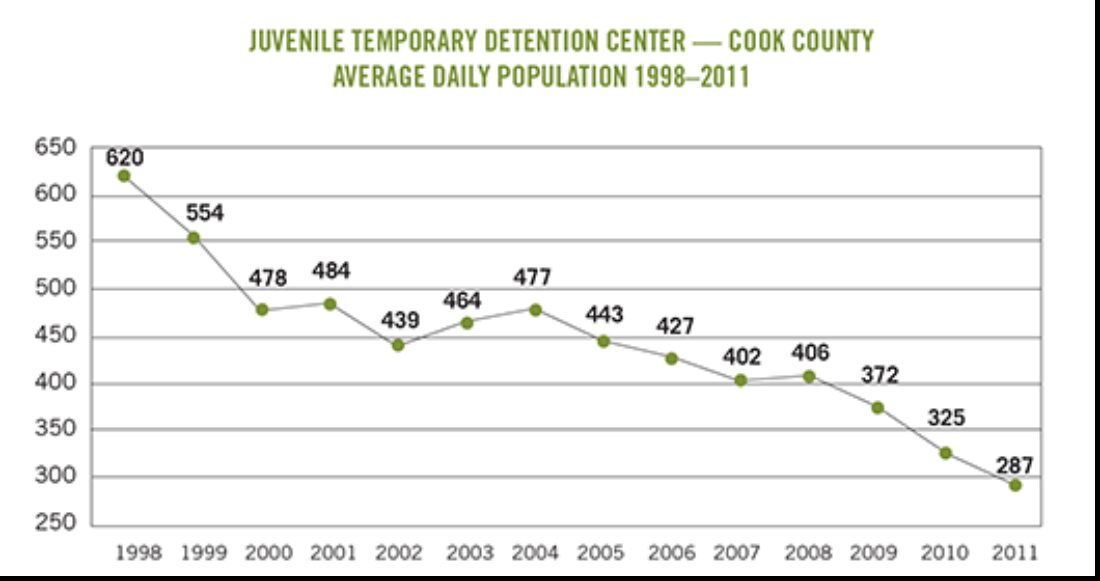A Conversation with Michael Rohan

Michael J. Rohan is the director of Probation and Court Services of the Circuit Court of Cook County, Illinois. Appointed in 1994, with previous administrative assignments, including the director of Adult Probation and Clinical Forensics Departments, he was appointed to chair Cook County’s Juvenile Detention Alternatives Initiative efforts in 1993 by the Chief Judge.
Cook County (Chicago), Illinois, is currently experiencing its lowest average daily population since becoming a JDAI site in 1994. The model JDAI site has reduced its detention population by 62 percent, going from a high of 750 in 1994 to 287 in 2011.
Because of its sustained efforts to lessen inappropriate or unnecessary detention, Cook County continues to prove that no matter how long a site has been working at detention reform, there are always opportunities for system improvements and innovations.
Between 2010 and 2012, the Juvenile Probation Department’s budget was reduced by 12 to 15 percent each year. This prompted the department to re-evaluate its use of out-of-home residential treatment facilities and as a result of that analysis, out-of-home placement dollars were redirected to community-based treatment programs
How did the new policy directing probation officers to exhaust all non-secure options for youth under the department’s care and supervision come about?
The policy evolved over the past five years, during which our department re-engineered our budget allocations from the long-term residential facilities to community-based therapy and supervision provided by our staff.
The combination of community-based contracts for Multisystemic Therapy, Functional Family Therapy, and in-house Cognitive Behavior Therapy provided by officers with post-graduate degrees, allowed judges viable options in lieu of out-of-home placements. The judges in our juvenile justice division are exceptional and they remain pro-active in advocating for pro-social resources for the kids and families who appear before them.
Please describe the new policy.
Presiding Judge Michael Toomin and the 16 judges in the Juvenile Justice Division regularly invite our department to present policy and program recommendations for their review and consideration. I presented a cost benefits/comparative analysis of the outcomes and per diem costs of community-based treatment versus long-term residential placements. The overview included the annualized fiscal projections and the costs associated with the community-based wrap-around therapeutic services/supervision.
The efficacy of long-term placements was also examined and there was a consensus that change was needed. The judges supported our proposal to examine all options to residential placements with the caveat that if exigent circumstances required the child to be removed from the home, it would remain our responsibility to pursue other viable options. It should be noted, in 1996, our court system had 425 minors in court-ordered/fiscally obligated residential placements. We now have two children in placement out of 5,500 cases under active supervision.
How has this new policy strengthened system operations overall?
This policy strongly reaffirms the court’s core value statement, of “the least restrictive setting without compromising public safety.” Judicial leadership is a critical component including their willingness to participate in developing policy and programs that empower family involvement in supporting case plans for the kids. Fiscally, the decision allowed our department to avoid layoffs of exceptionally dedicated, talented staff.
Please describe its impact.
The impact and efficacy of each therapeutic component of our clinical continuum are being monitored for outcomes, both short- and long-term. The response from the probation staff has been positive and supportive. They have participated in training on each of the therapeutic modalities and recognize their responsibilities to remain in active dialogue with the therapists. The judges have continued to be supportive and have joined committees recently reconvened to promote system reform.
Have you seen increased opportunity for collaboration among stakeholders?
Our court system was one of the original five JDAI sites convened by Bart Lubow back in 1992. Two basic tenets of our reform efforts were to be purposeful and strategic in collaboration and sustainability. True collaboration and empowerment of non-traditional partners fosters sustainability, which is evident in this our 20th year focusing on reform opportunities. Our community partners and the perspectives of our clients and families have broadened our awareness and paid dividends beyond our expectations. We have formalized both juvenile and family advisory groups as key advisors to our department.
How did detention reform contribute to your decision to limit out-of-home placements?
Clearly the decision to not utilize costly long-term residential placements was framed by both the fiscal and humanitarian considerations. We had to practice what we preached in moving away from an institutional response for the kids and families entrusted to our care and supervision and who were identified with mental health treatment concerns.
Fiscally, the investments were not benefiting our clients. We felt we were obligated to shift the paradigm and apply a different response to delinquency via the JDAI framework.
I remain very proud of my colleagues in the probation department for supporting this major policy shift. The leadership of our judges is evident on this issue and in their respective courtrooms throughout the year.





